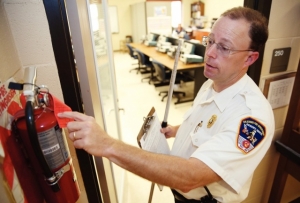Prevention, priceless
By John Joyce
Published in News on August 29, 2014 1:46 PM

News-Argus/MELISSA KEY
Fire Marshal Capt. John Morton checks to be sure a fire extinguisher is up to code at Wayne Early Middle College on Thursday afternoon. Schools must be inspected every six months -- one of the tasks Morton must perform to keep local buildings fire safe.
Firefighters have a tough job. Day or night, rain or shine, in 100-degree heat or in freezing temperatures, when the alarm goes off, they go.
And while the community is accustomed to seeing the big red trucks with lights flashing and sirens blaring, there is more to fire service work than just putting out fires.
"Fire prevention is a big part of what we do," Goldsboro Fire Chief Gary Whaley said.
And prevention begins with inspections.
"Inspections allow the fire service to stop a fire before it ever begins," Whaley said.
In the city of Goldsboro, much of the job of preventing fires falls to two men, Capt. John Morton, the city fire marshal, and Capt. Joe Johnson, its fire inspector.
Morton and Johnson began their careers together more than 24 years ago. The two studied at what is now Wilson Community College.
Morton became a fire inspector in 2008, and moved up to his current position as fire marshal.
He is also the son of a former assistant fire chief.
"My daddy was in fire prevention for 25 years. He was a captain before that and then he was assistant chief the last four years of his career," Morton said.
Johnson served in the U.S. Marine Corps before joining the fire service.
He and Morton went through the academy together and have been friends as long as he can remember, Morton said.
Other firefighters used to call the duo "Salt and Pepper."
"He saved my skin a few times," Morton said.
Morton is now in charge of making sure all the city's buildings are up to code.
Morton said he and Johnson perform five or six inspections daily. They also do fire department company inspections. Each company, or truck, is required to be inspected at regular intervals.
There are 17 trucks in the city, which means that when all the building inspections and fire company inspections are combined, the fire department conducts between 1,500 and 1,600 inspections a year.
When a new building is in the planning stages, Morton studies the site plans to be sure fire hydrants are included, sprinkler systems and stand pipes will be in place, and exit signs and fire alarms are going to be installed.
He also inspects each as the building is constructed. After it is built, a final inspection is made to ensure that all safety precautions have been met and a certificate of occupancy is issued.
As for existing buildings, any time there is a change of ownership or should a business change, from a retail shop to a restaurant, for example, it has to be inspected again.
Morton said he has seen many changes over his 24 years in the fire service.
Buildings have always been inspected by the city for construction codes compliance, but fire codes did not come into existence until 1991, he said.
Fire walls, in particular, serve to save lives and property. Most buildings built prior to the institution of fire codes have fire walls.
"I'll tell you what, they knew what they were doing when they built all those old buildings," Morton said. "Like when the Paramount burned, we could have lost the whole block had there not been fire walls."
